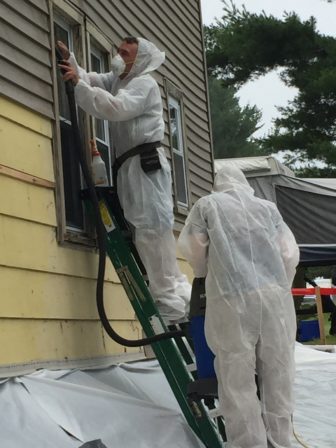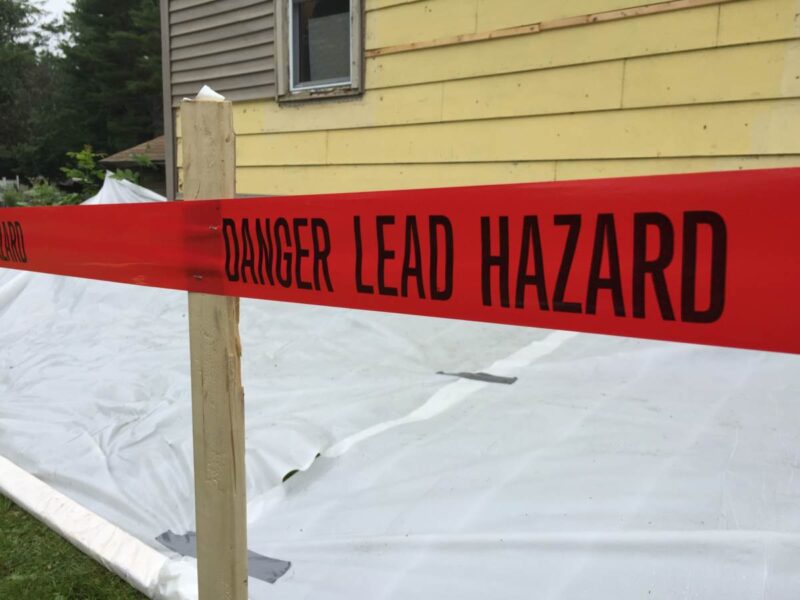Renovations of older buildings with lead paint on their walls is one of the major ways people in Maine get lead poisoning, which can cause lowered intelligence in children, lifelong behavior or attention problems, hearing deficiencies, kidney damage and slowed body growth.
Sen. Nathan Libby, a Democrat from Lewiston — which has the most severe lead paint problem in the state — introduced his bill to make renovations in Maine safer. His legislation requires EPA training and certification in lead-safe removal methods for at least one person on contracting crews that perform maintenance or renovation work on buildings built before 1978, when lead paint was still legal to use.
“I feel it is incumbent on us to bring state resources to bear in enforcing safe lead abatement and lead paint handling,” wrote Libby in his testimony.
Libby’s bill expands on a federal law requiring special safety training and certification for contractors doing painting, renovation and repair projects that disturb lead paint in homes, child care facilities and schools built before 1978.
That federal requirement, known as the Renovation, Repair and Painting Rule or “RRP Rule,” has rarely been enforced in New England. Only three enforcement actions of the EPA law had been mounted in Maine between 2010 and August 2015, although the agency stepped up enforcement in the Lewiston-Auburn area in mid-2016 after an investigation by the Maine Center for Public Interest Reporting revealed the agency’s lax administration of the law.

The EPA list of renovator firms certified to perform lead-safe work in the state has only 637 names of firms on it currently. That’s less than 15 percent of the 4,700 construction firms in the state, according to the U S. Census.
Libby’s bill had several advocates among those submitting testimony, including Amy Smith, a landlord who owns 13 rental units in downtown Lewiston.
“I support this bill because we must help the people who are willing to invest in the aging housing stock to ‘do the right thing,’” Smith wrote in her testimony.
But the bill ran into strong opposition Tuesday among landlords and the real estate industry, which turned out in force for the hearing before the legislative Committee on Labor, Commerce, Research and Economic Development. Chief among their complaints was that the proposed legislation expanded the scope of the federal law to routine maintenance projects.
“This is a well-intended law with very major unintended consequences,” said Daniel Bernier, a lawyer representing the Central Maine Apartment Owners Association, which includes owners of 600 apartment owners from the greater Waterville area.
“The easiest way to comply with this law if you’re an apartment owner is not to engage in routine maintenance,” said Bernier. “And the other thing is, if a second-floor apartment has a pipe burst and water is pouring down into the first-floor apartment, you can’t have a plumber fix that until you get somebody who’s EPA-certified there to engage in that repair.”
Committee member Sen. Shenna Bellows, D-Manchester, said she and her colleagues had “received numerous emails from property owners and contractors on both sides.
“We heard from many property owners who are concerned that the bill, as drafted, may be overbroad and … may sweep in contractors who are engaged in projects that may not have to do with lead paint removal,” said Bellows.
The state Department of Environmental Protection provided written testimony opposing the bill. Among the department’s objections, according to David Burns, director of the Bureau of Remediation and Waste Management, was that the legislation would duplicate the EPA’s enforcement efforts in the state.
“EPA conducts education and outreach, inspections, and enforcement in Maine to bring contractors into compliance with the RRP rule,” wrote Burns.
That assertion is despite the acknowledgment in 2015 by the RRP program’s administrator in the Environmental Protection Agency’s New England office that she doesn’t have enough staff to enforce the law— and neither do other EPA regional offices across the country.
“This is absolutely a national problem, there’s not enough resources to do it adequately,” said Sharon Hayes, manager of the toxics and pesticides program for the regional EPA.
“I’m sure we’re missing cases everywhere, not just Maine,” said Hayes. “We’ve probably had on the order of 20 some-odd cases in all of New England. It’s not a lot, but it’s the best we can do.”
EPA New England Spokesman Dave Deegan provided a statement Wednesday that said the agency’s stepped-up enforcement efforts in 2016 had not yet yielded any legal actions, but that they could.
“EPA has not formally concluded or announced other enforcement actions of lead paint disclosure or RRP requirements since last summer’s efforts in the Lewiston/Auburn area,” wrote Deegan.
During that 2016 initiative, Deegan wrote, “EPA did send Pre-inspection mailings to approximately 400 regulated entities (including plumbers with emphasis on lead in drinking water); EPA completed dozens of inspections to determine compliance with both RRP and Disclosure Rule requirements; and EPA is currently performing appropriate follow up actions on that work, results of which may be announced in the future.
“EPA takes our responsibility very seriously to help protect children and the public from lead paint hazards,” concluded Deegan.
But while the EPA has mounted a targeted effort in Lewiston-Auburn, there are lots of areas with lead-contaminated apartments and homes that aren’t seeing EPA enforcement. State experts estimate that there are 276,574 housing units in the state that are contaminated with lead and could potentially poison children.
The committee is scheduled to further consider the bill during a work session on Thursday, March 9, at 1 p.m.
After the public hearing, Libby said he was willing to amend his bill in light of objections.
“I’m going to ask the committee for some more time to work with opponents, advocates and committee members, and ask them not to vote this out” yet, said Libby. “I don’t want a party line vote, I want to take time to build support from committee members.”
To read more of the Center’s reporting on lead poisoning in Maine, click here.




